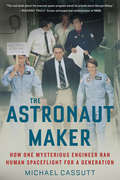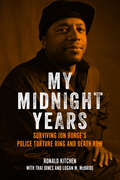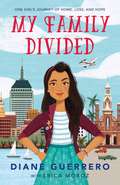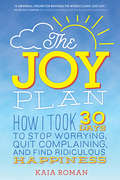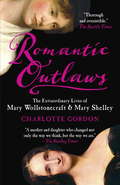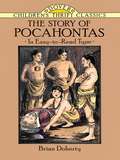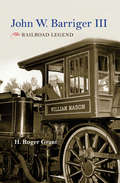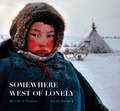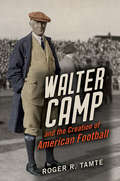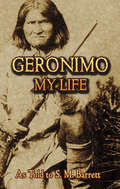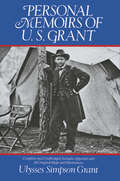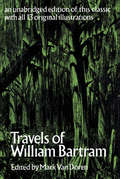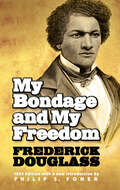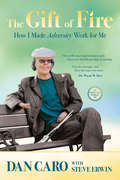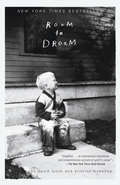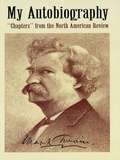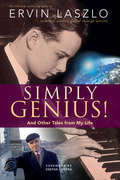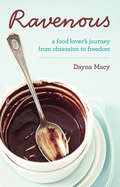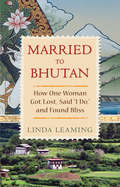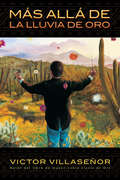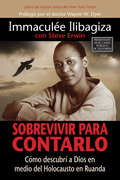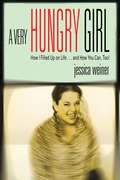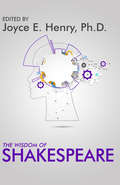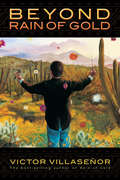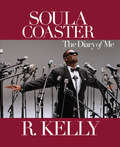- Table View
- List View
The Astronaut Maker: How One Mysterious Engineer Ran Human Spaceflight for a Generation
by Michael Cassutt"The real book about the manned space program would be a book about George Abbey." —Richard Truly, former astronaut and Administrator of NASA. <p><p>One of the most elusive and controversial figures in NASA's history, George W. S. Abbey was called "the Dark Lord," "the Godfather," and "UNO" (unidentified NASA official) by those within NASA. He was said to be secretive, despotic, a Space Age Machiavelli. Yet Abbey had more influence on human spaceflight than almost anyone in history. <p><p>From young pilot and wannabe astronaut to engineer, bureaucrat, and finally director of the Johnson Space Center ("mission control"), Abbey's story has never been fully told—until now. <p><p>The Astronaut Maker takes readers inside NASA to learn the real story of how Abbey rose to power and wielded it out of the spotlight. Over a 37-year career he oversaw the selection of every astronaut class from 1978 to 1987, deciding who got to fly, and when; was with the Apollo 1 astronauts the night before the fire that killed them in January 1967; was in mission control the night of the Apollo 13 accident and organized the recovery effort; led NASA's recruitment of women and minorities as Space Shuttle astronauts—including hiring Sally Ride; and much more. <p><p>By the coauthor of the acclaimed astronaut memoirs DEKE! and We Have Capture and informed by countless hours of interviews with Abbey and his family, friends, adversaries, and former colleagues, The Astronaut Maker is the ultimate insider's account of ambition and power politics at NASA.
My Midnight Years: Surviving Jon Burge's Police Torture Ring and Death Row
by Thai Jones Ronald Kitchen Logan McBrideRonald Kitchen was 21, on his way to buy milk for his four-year-old, when he was picked up by the Chicago police, brutally tortured, and coerced to confess to five counts of heinous murder. He spent 22 years in prison, 13 of those on death row, labeled as a monster. Kitchen was only one of the many victims of Jon Burge and his notorious midnight crew that terrorized and incarcerated black men—118 have come forward so far—on the South Side of Chicago for nearly two decades. Not one to give up, Kitchen cofounded the Death Row 10 from his maximum security cellblock. Together, these men fought to expose the grave injustices that led to their wrongful convictions. The Death Row 10 appeared on 60 Minutes II, Nightline, Oprah and Geraldo Rivera, and with the help of lawyers and activists outside, were instrumental in turning the tide against the death penalty in Illinois. Kitchen was finally exonerated in 2013 and filed a high profile lawsuit against the Chicago Police Department, Jon Burge, Mayor Richard Daley, and the Cook County State's Attorney. Kitchen's story is outrageous and heartbreaking. Largely absent from the current social justice narratives are the testimonies of the victims themselves. Kitchen is a rare survivor who has turned his suffering into a public cause and is poised to become a powerful spokesperson. The atrocities of the Midnight Crew have been brought to light through Kitchen's actions and are now part of the discussion as the nation engages in an unprecedented conversation about racism.
My Family Divided: One Girl's Journey of Home, Loss, and Hope
by Erica Moroz Diane GuerreroBefore landing a spot on the megahit Netflix show Orange is the New Black; before wow-ing audiences as Lina on Jane the Virgin; and before her incredible activism and work on immigration reform, Diane Guerrero was a young girl living in Boston. One day, while Guerrero was at school, her undocumented immigrant parents were taken from their home, detained, and deported. Guerrero's life, which had been full of the support of a loving family, was turned upside down.Reflective of the experiences of millions of undocumented immigrant families in the United States, Guerrero's story is at once heartbreaking and hopeful.
The Joy Plan: How I Took 30 Days to Stop Worrying, Quit Complaining, and Find Ridiculous Happiness
by Kaia RomanAs a mother, a wife, and a businesswoman, Kaia Roman always had a plan. But when her biggest plan, the business she cofounded, collapsed, Kaia found herself crushed by depression. And what felt even worse was that, with a husband and two kids relying on her to get out of bed, she didn't have a plan to move forward. Determined to turn her life around and put her ingrained habits of stress and anxiety behind her, Kaia decided to put everything else on hold and dedicate thirty days to the singular pursuit of joy. The results were astonishing-and lasted much longer than the initial monthlong project.In this uplifting and eye-opening memoir, Kaia uses her business savvy to create a concrete Joy Plan to get back on her feet fast. Using scientific research on hormones, neurotransmitters, and mindfulness, along with the daily dedication to creating a more joyful existence, Kaia teaches readers how to move past temporary happiness and succeed in creating joy that lasts. Complete with advice, exercises, and key takeaways, The Joy Plan is Kaia's step-by-step guide to how she, and everyone else, can ditch the negative and plan for the joy in their lives.
Romantic Outlaws: The Extraordinary Lives of Mary Wollstonecraft and Her Daughter Mary Shelley
by Charlotte GordonThis groundbreaking dual biography brings to life a pioneering English feminist and the daughter she never knew. Mary Wollstonecraft and Mary Shelley have each been the subject of numerous biographies, yet no one has ever examined their lives in one book--until now. In Romantic Outlaws, Charlotte Gordon reunites the trailblazing author who wrote A Vindication of the Rights of Woman and the Romantic visionary who gave the world Frankenstein--two courageous women who should have shared their lives, but instead shared a powerful literary and feminist legacy. In 1797, less than two weeks after giving birth to her second daughter, Mary Wollstonecraft died, and a remarkable life spent pushing against the boundaries of society's expectations for women came to an end. But another was just beginning. Wollstonecraft's daughter Mary was to follow a similarly audacious path. Both women had passionate relationships with several men, bore children out of wedlock, and chose to live in exile outside their native country. Each in her own time fought against the injustices women faced and wrote books that changed literary history. The private lives of both Marys were nothing less than the stuff of great Romantic drama, providing fabulous material for Charlotte Gordon, an accomplished historian and a gifted storyteller. Taking readers on a vivid journey across revolutionary France and Victorian England, she seamlessly interweaves the lives of her two protagonists in alternating chapters, creating a book that reads like a richly textured historical novel. Gordon also paints unforgettable portraits of the men in their lives, including the mercurial genius Percy Shelley, the unbridled libertine Lord Byron, and the brilliant radical William Godwin. "Brave, passionate, and visionary, they broke almost every rule there was to break," Charlotte Gordon writes of Wollstonecraft and Shelley. A truly revelatory biography, Romantic Outlaws reveals the defiant, creative lives of this daring mother-daughter pair who refused to be confined by the rigid conventions of their era.Advance praise for Romantic Outlaws "A fascinating, thoughtful and continuously absorbing book, one to which I know I shall return on many future occasions."--Miranda Seymour, author of Mary Shelley"Charlotte Gordon reunites a mother and daughter tragically separated at birth in this rousing and surpassingly readable epic spanning the Romantic era. Wordsworth and Byron must step aside to make room for two brilliant women, Mary Wollstonecraft and her daughter Mary Shelley, early and late Romantics whose remarkable contributions to their time and ours lend Gordon's artfully twined tale special significance."--Megan Marshall, Pulitzer Prize-winning author of Margaret Fuller: A New American Life "Romantic Outlaws is a gripping account of the heartbreaks and triumphs of two of history's most formidable female intellectuals, Mary Wollstonecraft and Mary Shelley. Gordon has reunited mother and daughter through biography, beautifully weaving their narratives for the first time."--Amanda Foreman, author of A World on Fire "Mary Wollstonecraft and her daughter Mary Shelley stand out as daring, unconventional, and courageous women--in their times and ours. Appreciate the 'heroic exertions' of their lives and savor the skill with which Charlotte Gordon tells their intersecting stories."--Susan Ware, general editor, American National BiographyFrom the Hardcover edition.
The Story of Pocahontas (Dover Children's Thrift Classics)
by Brian DohertyThe exciting and poignant story of an Indian princess who saves the life of a captured colonial leader -- from her years of captivity in Virginia, eventual marriage to John Rolfe and their journey to England to her tragic, early death. Illustrated edition lets youngsters relive the life and times of a remarkable woman.
John W. Barriger III: Railroad Legend (Railroads Past and Present)
by H Roger GrantIn John W. Barriger III: Railroad Legend, historian H. Roger Grant details the fascinating life and impact of a transportation tycoon and "doctor of sick railroads." After graduating from the Massachusetts Institute of Technology, John W. Barriger III (1899–1976) started his career on the Pennsylvania Railroad as a rodman, shop hand, and then assistant yardmaster. His enthusiasm, tenacity, and lifelong passion for the industry propelled him professionally, culminating in leadership roles at Monon Railroad, Pittsburgh and Lake Erie Railroad, Missouri-Kansas-Texas Railroad and the Boston and Maine Railroad. His legendary capability to save railroad corporations in peril earned him the nickname "doctor of sick railroads," and his impact was also felt far from the train tracks, as he successfully guided New Deal relief efforts for the Railroad Division of the Reconstruction Finance Corporation during the Depression and served in the Office of Defense Transportation during World War II. Featuring numerous personal photographs and interviews, John W. Barriger III is an intimate account of a railroad magnate and his role in transforming the transportation industry.
Somewhere West of Lonely: My Life in Pictures
by Steve RaymerIn his travels around the globe, National Geographic photojournalist Steve Raymer has often been the first on the scene, recording unfolding events and revealing the connections that tie us together. Raymer’s photography captures the magic of beautiful vistas, the joys and struggles of everyday people living everyday lives, and the chaos brought on by natural disasters. Beyond documenting tragedies like the devastating famines in Bangladesh and Ethiopia and exposing the massive corruption crippling the Trans-Alaska Pipeline, his work tells a complex and wide-ranging story about life and human nature. Now, for the first time, Somewhere West of Lonely reveals the stories behind the camera lens in a gorgeous, intimate tour of Steve Raymer’s remarkable life and reporting. Bringing together 150 photographs from countries across the globe, this incredible book reveals our world and time as it is—everyday people caught up in life-changing events; acts of resilience and corruption; and, always, lingering moments of transcendence and beauty.
Walter Camp and the Creation of American Football
by Roger R TamteWalter Camp made the development of football--indeed, its very creation--his lifelong mission. From his days as a college athlete, Camp's love of the game and dedication to its future put it on the course that would allow it to seize the passions of the nation. Roger R. Tamte tells the engrossing but forgotten life story of Walter Camp, the man contemporaries called "the father of American football." He charts Camp's leadership as American players moved away from rugby and for the first time tells the story behind the remarkably inventive rule change that, in Camp's own words, was "more important than all the rest of the legislation combined." Trials also emerged, as when disputes over forward passing, the ten-yard first down, and other rules became so public that President Theodore Roosevelt took sides. The resulting political process produced losses for Camp as well as successes, but soon a consensus grew that football needed no new major changes. American football was on its way, but as time passed, Camp's name and defining influence became lost to history. Entertaining and exhaustively researched, Walter Camp and the Creation of American Football weaves the life story of an important sports pioneer with a long-overdue history of the dramatic events that produced the nation's most popular game.
Geronimo: My Life (Native American)
by Geronimo S. M. BarrettIn this, one of Native American history's most extraordinary documents, a legendary warrior and shaman recounts the beliefs and customs of his people. Completely and utterly authentic, its captivating narrator is the most famous member of the Apache tribe: Geronimo.The spiritual and intellectual leader of the American Indians who defended their land from both Mexico and the United States for many years, Geronimo surrendered in 1886. Two decades later, while under arrest, he told his story through a native interpreter to S. M. Barrett, an Oklahoma school superintendent. Barrett explains in his introduction, "I wrote to President Roosevelt that here was an old Indian who had been held a prisoner of war for twenty years and had never been given a chance to tell his side of the story, and asked that Geronimo be granted permission to tell for publication, in his own way, the story of his life."This remarkable testament is the result. It begins with Geronimo's retelling of an Apache creation myth and his descriptions of his youth and family. He explains his military tactics as well as traditional practices, including hunting and religious rituals, and reflects upon his hope for the survival of his people and their culture.
Personal Memoirs of U. S. Grant (Civil War Ser.)
by Ulysses Simpson GrantIntelligent, deeply moving firsthand account of Civil War military campaigns by former U.S. President and key figure in the Union's victory. Perhaps the finest military memoir ever written, the volume offers an incomparable vantage point on that conflict. Includes Grant's letters to his wife, photographs by Mathew Brady, maps, and more.
Travels of William Bartram
by William BartramFirst inexpensive, illustrated edition of early classic on American geography, plants, Indians, wildlife, early settlers. Naturalist's poetic, lovely account of travels through Florida, Georgia, Carolinas from 1773 to 1778. Influenced Coleridge, Wordsworth, Chateaubriand. "A book of extraordinary beauty..." -- New York Times. 13 illustrations.
My Bondage and My Freedom: The Givens Collection (African American)
by Frederick Douglass"I have never placed my opposition to slavery on a basis so narrow as my own enslavement, but rather upon the indestructible and unchangeable laws of human nature, every one of which is perpetually and flagrantly violated by the slave system." -- Frederick DouglassBorn and brought up in slavery, Frederick Douglass (1818-1895) experienced the horrors of bondage but gained freedom and world renown as a lecturer, editor, and one of the most important men behind the American abolitionist movement. This book is the deeply moving story of his life -- as a slave, and as a free man.Douglass wrote three autobiographies, of which the 1855 edition is the most detailed on his life as a slave. In it, readers are not spared the fullest and most graphic descriptions of the cruelty of slavery. Douglass describes his life on a Maryland plantation: the excitement and danger of teaching himself to read and write, his demoralization under a cruel master, and his daring escape.In the second part of his tale, Douglass, now a fugitive, settles in Massachusetts and joins the anti-slavery movement. He recounts his travels to the British Isles and his first taste of freedom without prejudice, and his return to America to work as spokesman for his oppressed people. In addition to recording his sufferings and his protests, Douglass also provides a keen analysis of the effects of slavery on its victims as well as on society at large.
The Gift of Fire: How I Made Adversity Work For Me
by Dan CaroDan Caro has been proving the world wrong since he was in diapers. When he was two years old, he was engulfed in a fireball during a gasoline explosion in the family garage and was left with third-degree burns over most of his body—so severe that doctors held out little hope he’d survive more than a few days. Dan was in such excruciating pain that his devastated parents silently prayed for God to end their son’s suffering and welcome him into heaven. And it seemed as if God was willing to oblige—Dan technically died on the operating table several times in the hours following the accident. But even though his heart stopped, Dan’s spirit wasn’t ready to give up . . . somehow he knew he had work to do. Despite the odds, Dan survived, but life would not be easy. The fire left him badly maimed and disfigured. His hands were burned away, as was most of his skin and nearly all of his face. He would endure years of painful surgeries and endless months of lonely isolation in burn units, only to suffer the agony of social rejection, shunned and called "monster" by both children and adults in his Louisiana hometown. With the support of his loving parents and siblings, Dan did not despair. He kept his heart open to the world and focused on the positive energy around him. Before his sixth birthday, he vowed that his life would not be defined by the way others saw him or the restrictions of his so-called physical handicaps. Dan set himself a series of life goals, starting with the art of tying his shoelaces without fingers. Once he had achieved that milestone, he decided he could do anything . . . so why not learn to play the drums? When Dan was told he’d never be able to do so, he promised himself that one day he’d become one of the most accomplished drummers in the city that gave jazz its name—New Orleans! Since that day, Dan’s music has inspired thousands, and many more have also been inspired by his personal philosophy of focusing on the positive, refusing to accept limits, and living life with an open heart. Today, the young man who was once shunned and called "monster" by his neighbors is very much in demand as a public speaker and travels the country encouraging others to not just overcome life’s hardships, but to view adversity as a gift that can drive us toward reaching our full potential. This is Dan’s first book.
Room to Dream: A Life In Art
by David Lynch Kristine McKennaAn unprecedented look into the personal and creative life of the visionary auteur David Lynch, through his own words and those of his closest colleagues, friends, and family In this unique hybrid of biography and memoir, David Lynch opens up for the first time about a life lived in pursuit of his singular vision, and the many heartaches and struggles he’s faced to bring his unorthodox projects to fruition. Lynch’s lyrical, intimate, and unfiltered personal reflections riff off biographical sections written by close collaborator Kristine McKenna and based on more than one hundred new interviews with surprisingly candid ex-wives, family members, actors, agents, musicians, and colleagues in various fields who all have their own takes on what happened. Room to Dream is a landmark book that offers a onetime all-access pass into the life and mind of one of our most enigmatic and utterly original living artists. With insights into . . . Eraserhead The Elephant Man Dune Blue Velvet Wild at Heart Twin Peaks Twin Peaks: Fire Walk with Me Lost Highway The Straight Story Mulholland Drive INLAND EMPIRE Twin Peaks: The Return
My Autobiography: "Chapters" from the North American Review
by Mark TwainFamed author's plain-spoken words -- recorded as character sketches, essays, diary entries, letters and more -- recall his boisterous boyhood in Hannibal, Missouri, life as a riverboat pilot, as a young adult in rough Nevada mining towns, years spent as an author, plus somber passages noting the death of his wife and their three children.
Simply Genius!: And Other Tales From My Life: An Informal Autobiography
by Ervin LaszloAn autobiography usually recounts the life of a person who has achieved wide acclaim in one field. But this extraordinary book describes the life of someone who has achieved international acclaim in three fields! Ervin Laszlo was a child prodigy on the piano and grew up to become an internationally celebrated virtuoso. By the time he reached his 40s, however, he had become a famous scientist and philosopher, and had written a dozen books and more than a hundred articles. He also taught at major universities in Europe, the U.S., and the Far East. Shortly thereafter, he gained world renown as a global visionary, heading research programs at the United Nations and founding an international think tank (the Club of Budapest). But this book is not an autobiography in the traditional sense. In Laszlo’s own words: "I don’t like talking about myself, about what makes me tick and why. Writing about all the things that have happened to me is different. This is storytelling—the telling of a real, lived story: my story, as it unfolded over the years." Join the author on his remarkable journey from his days as an internationally acclaimed concert pianist . . . to his profoundly personal quest to effect positive global transformation!
Ravenous: A Food Lover's Journey From Obsession To Freedom
by Dayna MacyWhat should I eat? How much should I eat? What does it mean to be nourished? How can I, a food lover and lifelong overeater, learn to be satisfied? These are the questions Dayna Macy asks in her debut memoir, Ravenous. Like many of us, Macy has had a complicated relationship with food. In order to transform this relationship, Macy embarks on a year-long journey to uncover the origins of her food obsessions. From her childhood home in upstate New York, and back up the California coast, Macy travels across the country, meeting with farmers, food artisans, butchers, a Zen chef, a forager, a chocolatier, and others—to understand where her meals come from, why she craves certain foods, and what food means to her. She looks at how nostalgia is deeply embedded in food, and how the powerful forces of family and tradition shape our food choices. Rather than head straight for the diet manuals, she chooses to change her relationship with food from the inside out. She delves deeper into the spiritual underpinnings of eating, examines what it means to be satisfied, and ultimately forges her own path to balance and freedom.
Married to Bhutan: How One Woman Got Lost, Said "i Do," And Found Bliss
by Linda LeamingTucked away in the eastern end of the Himalayas lies Bhutan: a tiny, landlocked country bordering China, India, and Nepal. One of the most remote places in the world, Bhutan is rich in natural beauty, exotic landscapes, and ancient wisdom, where people are genuinely happy with very few material possessions and the government embraces "Gross National Happiness" instead of Gross National Product. As one of the few Americans to have lived in Bhutan, Linda Leaming offers a rare glimpse at the peaceful mountain kingdom so many have only dreamed of. For over ten years, Leaming has lived and taught in the small town of Thimphu, where there are fewer than 100,000 people and no traffic lights. "If enlightenment is possible anywhere," she writes, "I think it is particularly possible here." The Bhutanese way of life—quieter, slower, and more tranquil—can seem daunting to most Westerners, consumed with time, dates, speed, and efficiency. In Bhutan, people rarely check their e-mail and take their time answering their telephones. But, as Leaming shows us, a little patience—over a cup of warm tea and friendly conversation—can help soothe the most distressed mind and soul. In this funny, magical memoir, Leaming takes us with her on her travels through South Asia, sharing her experiences as she learns the language, customs, and religion; folklore of a revered Tibetan holy man who gave blessings to the people by whacking them on the head with a big wooden phallus; her unlikely romance with a Buddhist artist; and her discoveries about the unexpected path to happiness and accidental enlightenment, where true bliss resides. Married to Bhutan is a reminder that following our dreams is the way to be truly happy.
Más Allá De La Lluvia De Oro
by Victor VillaseñorNow in Spanish!Beyond Rain of Gold is the incredible story of acclaimed author Victor Villaseñor’s initiation into the spiritual realm.Decades ago, after penning the nonfiction epic Rain of Gold, the writer embarked on a life-changing journey. In the process of ensuring that his family’s saga would be published as the authentic, true account it was, Villaseñor forged a sacred bond with his father and his indigenous ancestors, who were guiding him from the Other Side. The book eventually became a national bestseller and an enduring favorite of millions of readers.Yet the story doesn’t end there. Villaseñor’s connection with the Spirit World continued to deepen, awakening him to the ongoing miracles inherent in everyday living. He discovered that his life had suddenly taken on a magical quality, with events occurring that transcended the boundaries of what is normally considered "reality."A series of mystical encounters with Spirit convinced Villaseñor that not only is there no firm line between life and death—but that the time has come in our collective "human-story" to usher in a new era of abundance, peace, and harmony on our beloved Mother Earth and among all of humanity!Similar to Carlos Castaneda’s body of work, this exciting, raw, and honest book courageously delves into altered states of consciousness that exist alongside ordinary reality . . . ultimately revealing the Spiritual Wisdom that is available to each and every one of us.Beyond Rain of Gold will truly transform the way you see the world.
Sobrevivir Para Contarlo
by Immaculee IlibagizaUna parte de las utilidades recaudadas por la venta de este libro será destinada a la Fundación Benéfica de SOBREVIVIR PARA CONTARLO, la cual ayuda a los niños de África a llevar una mejor vida. Por favor vaya a la página___ para información sobre pedidos del brazalete LEFT TO TELL. Todo el dinero recaudado por la venta de los brazaletes será destinado a la Fundación Benéfica.
A Very Hungry Girl: How I Filled Up On Life... And How You Can, Too!
by Jessica WeinerA Very Hungry Girl chronicles the journey of Jessica Weiner, who spent most of her life hungering to be someone else. She was so desperate to be accepted and valued that she spiraled into an eating disorder, experiencing the attendant lack of self-esteem that rules—and almost ruined—her life. This compelling book relates Jessica's very personal story, and also captures her unique persona as she travels the country as a performer and motivational speaker listening to thousands of other people's stories. Through her work, Jessica has become the voice of her generation and speaks with a relatable and realistic point of view. Jessica's work has received national attention by The Washington Post, CNN, MTV and Teen People Magazine.
The Wisdom of Shakespeare
by Joyce HenryIf the transparent pictures of a cinematograph roll were found clipped apart in a medley of separate pictures, the test of their reunion in a reconstituted film would be the air of life in the moving picture thrown from it on the shimmering screen. <P><P>And so it is with those elements of a living portrait to be found in the extra-dramatic bits of Shakespeare's work. This statement has been made before; has been supported; has been denied. The present writer says merely Read and judge.
Beyond Rain of Gold
by Victor VillaseñorBeyond Rain of Gold is the incredible story behind the writing and publication of Victor Villaseñor’s national bestseller Rain of Gold. <P><P>It captures the difficult and courageous path the author followed to ensure that his family’s saga would be published as the authentic, true account it is. The real power of this book lies in the sacred relationship that Villaseñor has with his father, mother, and ancestors. In other words, Beyond Rain of Gold encompasses the magical messages that Villaseñor’s indigenous ancestors told him are universal themes common to native peoples everywhere on this planet . . . and at one time we were all indigenous. <P><P>This is an exciting, raw, and honest work, with events occurring that transcend the boundaries of what we normally call reality. And like Carlos Castaneda’s Don Juan trilogy, Beyond Rain of Gold explores altered states of consciousness, revealing the wisdom and magic inherent in everyday existence. <P><P>This is a book that will make you see the world in an entirely different way, and which will stimulate your mind and emotions to create a New Earth way of thinking and being!
Soulacoaster: The Diary Of Me
by R. KellyWho is R. Kelly? Three-time Grammy winner, who has sold more than 35 million records worldwide. Legendary writer and producer, who collaborated with such music icons as Michael Jackson, Celine Dion, Jay-Z, and Aretha Franklin. Visionary cultural messenger, who created the hip hopera phenomenon Trapped in the Closet. Creative genius. Sex symbol. The man who puts the "R" in R&B. Through the iconic anthem "I Believe I Can Fly" and such sexy R&B mega-hits as "Bump N’ Grind," "Ignition," and "When a Woman’s Fed Up," R. Kelly has proven to be one of the greatest musical talents of his generation. Yet his rollercoaster ride to the top has been as perilous as it has been exhilarating. In Soulacoaster: The Diary of Me, Kelly shares his life story through episodic tales and exclusive color photographs, exploring his meteoric rises and sudden falls. From the crippling learning disorder that rendered him unable to read or write, to the teacher/mentor who prophesized that his destiny was in music, not basketball, we follow his evolution from Chicago street performer to struggling L.A. musician and beyond. Kelly reveals his hard-won ascent to superstardom and his battle to move forward after legal and personal ordeals that threatened to destroy his life. Now back at the top, Kelly recounts the surprising twists and turns that have taken him to new heights of maturity and artistry. Part memoir, part keepsake, Soulacoaster unlocks the door to R. Kelly’s story as only he can tell it, promising his fans an intimate and unforgettable ride.
